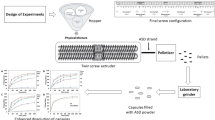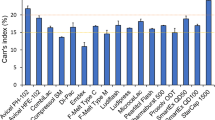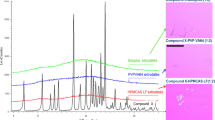Abstract
This study was designed to assess the value of isothermal microcalorimetry (ITMC) as a quality by design (QbD) tool to optimize blending conditions during tablet preparation. Powder mixtures that contain microcrystalline cellulose (MCC), dibasic calcium phosphate dihydrate (DCPD), and prednisone were prepared as 1:1:1 ratios using different blending sequences. ITMC was used to monitor the thermal activity of the powder mixtures before and after each blending process. Differential scanning calorimetry (DSC) and X-ray powder diffraction (XRPD) were performed on all final powder mixtures. Final powder mixtures were used to prepare tablets with 10 mg prednisone content, and dissolution tests were performed on all tablet formulations. Using ITMC, it was observed that the powder mixtures had different thermal activity depending on the blending sequences of the ingredients. All mixtures prepared by mixing prednisone with DCPD in the first stage were associated with relatively fast and significant heat exchange. In contrast, mixing prednisone with MCC in the first step resulted in slower heat exchange. Powder mixture with high thermal activity showed extra DSC peaks, and their dissolution was generally slower compared to the other tablets. Blending is considered as a critical parameter in tablet preparation. This study showed that ITMC is a simple and efficient tool to monitor solid-state reactions between excipients and prednisone depending on blending sequences. ITMC has the potential to be used in QbD approaches to optimize blending parameters for prednisone tablets.





Similar content being viewed by others
References
Xie L, Wu H, Shen M, Augsburger LL, Lyon RC, Khan MA, et al. Quality-by-design (QbD): effects of testing parameters and formulation variables on the segregation tendency of pharmaceutical powder measured by the ASTM D 6940-04 segregation tester. J Pharm Sci. 2008;97:4485–97.
Yu LX. Pharmaceutical quality by design: product and process development, understanding, and control. Pharm Res. 2008;25:781–91.
J. Woodcock. The concept of pharmaceutical quality. Am. Pharm. Rev; 2004, p. 1–3
Lionberger RA, Lee SL, Lee L, Raw A, Yu LX. Quality by design: concepts for ANDAs. Aaps J. 2008;10:268–76.
Sinka IC, Motazedian F, Cocks ACF, Pitt KG. The effect of processing parameters on pharmaceutical tablet properties. Powder Technol. 2009;189:176–84.
Berthiaux H, Marikh K, Gatumel C. Continuous mixing of powder mixtures with pharmaceutical process constraints. Chemical Engineering and Processing: Process Intensification. 2008;47:2315–22.
Lindley JA. Mixing processes for agricultural and food materials: 3. Powders and particulates. J Agric Eng Res. 1991;49:1–19.
Bellamy LJ, Nordon A, Littlejohn D. Real-time monitoring of powder mixing in a convective blender using non-invasive reflectance NIR spectrometry. Analyst. 2008;133:58–64.
Sekulic SS, Ward II HW, Brannegan DR, Stanley ED, Evans CL, Sciavolino ST, et al. On-line monitoring of powder blend homogeneity by near-infrared spectroscopy. Anal Chem. 1996;68:509–13.
Harwood CF, Walanski KA. Monitoring the mixing of powders. Am Chem Soc Div Org Coatings Plast Chem Prepr. 1973;33:508–15.
Schofield C. The definition and assessment of mixture quality in mixtures of particulate solids. Powder Technol. 1976;15:169–80.
Al-Hallak MHDK, Xu Z, Ghaffari F, Löbenberg R. The effect of compression forces on the stability of dibasic calcium phosphate dihydrate tablets in the presence of glutamic acid hydrochloride monitored by isothermal calorimetry. Thermochimica Acta. 2007;467:86–90.
Selzer T, Radau M, Kreuter J. The use of isothermal heat conduction microcalorimetry to evaluate drug stability in tablets. Int J Pharm. 1999;184:199–206.
Bucktonand G, Darcy P. Assessment of disorder in crystalline powders—a review of analytical techniques and their application. Int J Pharm. 1999;179:141–58.
Tian F, Zhang F, Sandler N, Gordon KC, McGoverin CM, Strachan CJ, et al. Influence of sample characteristics on quantification of carbamazepine hydrate formation by X-ray powder diffraction and Raman spectroscopy. Eur J Pharm Biopharm. 2007;66:466–74.
Jablonski P, Müller-Blecking A, Borchard W. A method to determine mixing enthalpies by DSC. J Therm Anal Calorim. 2003;73:779–87.
Azarmi S, Roa W, Lobenberg R. Current perspectives in dissolution testing of conventional and novel dosage forms. Int J Pharm. 2007;328:12–21.
Gaisford S. Stability assessment of pharmaceuticals and biopharmaceuticals by isothermal calorimetry. Curr Pharm Biotechnol. 2005;6:181–91.
Urakami K. Characterization of pharmaceutical polymorphs by isothermal calorimetry. Curr Pharm Biotechnol. 2005;6:193–203.
Shah B, Kakumanu VK, Bansal AK. Analytical techniques for quantification of amorphous/crystalline phases in pharmaceutical solids. J Pharm Sci. 2006;95:1641–65.
Costa P, Sousa LJ. Modeling and comparison of dissolution profiles. Eur J Pharm Sci. 2001;13(2):123–33.
Author information
Authors and Affiliations
Corresponding author
Additional information
Guest Editor: Susan D’Souza
Rights and permissions
About this article
Cite this article
Al-Hallak, M.H.D.K., Azarmi, S., Xu, Z. et al. Isothermal Microcalorimetry as a Quality by Design Tool to Determine Optimal Blending Sequences. AAPS J 12, 417–423 (2010). https://doi.org/10.1208/s12248-010-9202-4
Received:
Accepted:
Published:
Issue Date:
DOI: https://doi.org/10.1208/s12248-010-9202-4




